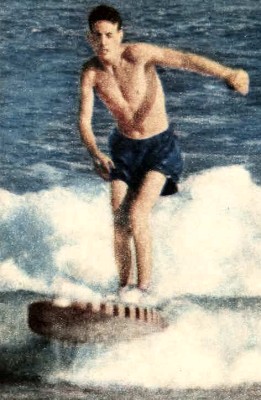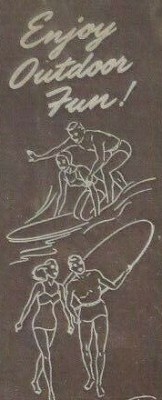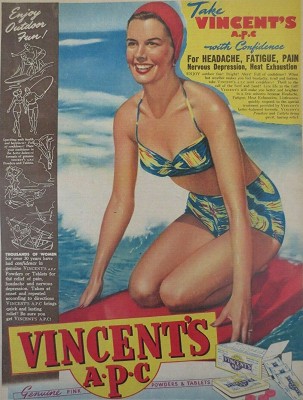
newspapers : 1952
| home | catalogue | history | references | appendix |
 |
surfresearch.com.au
newspapers : 1952 |
|
|
|
|
|
| The Australian Women's Weekly
Wednesday 9 January 1952, page 16. Now for the long, hot days of SUMMER.... SUMMER
GLADNESS. Nearly everyone enjoys week-ends in the sun. SUMMER
SURFING. Trove
|
 |
| The Australian Women's
Weekly 23rd January 1952, page 36. Vincent's Powders and Tablets. |
 |
 |
SURF MEMBERS IN BITTER PROTEST
Thirty-eight
lifesavers were disqualified in the surf- board race at
Manly carnival yesterday.
The water
referee, Mr. Lionel McDonald, disqualified the riders for
not completing the course he had outlined at the start of
the race.
Only five
competitors rounded the correct buoy, and their leader, D.
Cahill (Coogee) was declared the winner.
Other riders
protested against their disqualification.
Their
leading spokesman, Graham Ferris (Tamarama), has been cited
to appear before the S.L.S.A. on Tuesday night for alleged
remarks to the referee.
...
Former
Australian surf ski champion Les Lazarus (Newcastle) made
his first Sydney appearance of the season.
Lazarus won
the single ski race and then took part in the double ski
event.
He and his
partner finished three feet behind the winners.
...
Surf Board
Race- E Cahill (Coogee), 1. G Bevan (Coogee), 2. T McMahon
(Bronte) 3.
Doubles Surf Ski Race- Mulcay brothers (North Cronulla), 1. Lazarus and Conolly (Newcastle), 2. Brown and Rowswell (Maroubra) 3.
Best Surf In The World
By Craig
McGregor
With the surfing season officially opening next Wednesday, hundreds of thousands of Australians will soon be visiting beaches to enjoy Australia's national pastime surfing.
It may seem
an immodest claim, but there is little doubt that Australia
has the best beaches and the best surf in the world.
Only
Australia, New Zealand, South Africa, Ceylon, the southern
States of U.S. and some Pacific islands have a surf at all.
At this time
of the year especially, we should pay tribute to a
Sydneysider, Mr. W. H. Gocher, who, 50 years ago, won for
Australians the right to all-day surfing.
Australians
had, of course, been surfing long before Mr. Gocher breasted
the waves, although no one seems to know when or with whom
it began.
At all
events, by 1880 many young Australians were bathing
regularly at Sydney's near-deserted beaches.
But surfing
in those days was a clandestine affair- something to be
indulged in early in the morning before too many people were
about.
For the law
expressly forbade (and still forbids) public bathing between
6 a.m. and 8 p.m.
In 1902,
Gocher, a journalist, announced that at noon on the
following Sunday he would defy the law and publicly bathe at
Manly beach.
True to his
word, and before a large crowd of onlookers, Gocher carried
out his promise.
He was not
arrested, and since then Australians have surfed during the
forbidden hours without interference.
Perhaps the
most famous feature of Australian surfing are our
Iifesavers.
The
Australian voluntary system of surf lifesaving is unique,
and the tanned lifesaver with his bright club, cap, who pays
an average of 15/- a year for the privilege of saving your
life, is as much a product of Australia as the kangaroo and
kookaburra.
Since they
began formal operations, surf Iifesavers have saved the
lives of more than 80,000 people. To-day, there are more
than 165 surf lifesaving clubs in Australia with a total
membership of about 12,500.
Surf-lifesaving
has
come a long way sjnce the days of 1907, when á few
youngsters formed lifesaving clubs at some Sydney beaches
"just for the fun of it."
Two years
later, representatives of these clubs met to form the Surf
Bathing Association of New
South Wales.
The movement
spread rapidly, and clubs were formed in Victoria, Western
Australia, Queensland and New Zealand.
In 1920, the
association changed its name to the Surf Life Saving
Association of N.S.W., and three years later it adopted its
present name of Surf Life Saving Association of Australia.
SYDNEY
TO-DAY
- Slightly
in advance of the official opening of our surf season,
Sydney's 18-footer sailing skiffs are out, lending colour
and personality to the harbour's blue waters.
Above, a
crew prepares its skiff at Double Bay for an afternoon's
racing.
To-day,
there are Surf Life Saving clubs in every State except the
Northern Territory.
Australians
have developed many unique contrivances to meet the demands
of the surf.
Our first
surfboat was designed by Fred Notting, a Manly club member,
who gave it distinctive high ends and a curved keel.
Manly was
the first club to use a surfboat; it proved such a success
that all the other clubs adopted the idea as soon as they
could raise the money.
The
lifesaving reel and belt, the surf ski, and the rubber
surfoplane all originated in Australia.
The Eve
resuscitation rocker used on beaches here is an Australian
adaptation of an English invention.
The flippers
used by surfers to-day were developed from the type of
flippers used by frogmen in World War II.
The original
surfboard was not Australian; it was introduced here by Duke
Kahanamoku, a visiting Hawaiian swimmer, in 1914.
Australian
surfboard riders, however, soon modified the short, broad
boards of the Hawaiians, which were constructed of solid
wood.
By 1925, we
had developed the hollow surfboard, which is much faster
than solid boards.
The
Australian surfboard today is a long, narrow board with
pointed ends and continuously curved sides, and is
completely hollow.
The art of
"body shooting," or catching a wave so that it carries the
surfer with it for hundreds of yards, is almost exclusively
Australian.
Since its
development early in the century, Australian surfers have
introduced many improvements on the original body-shooting
style.
The art of
shooting waves with arms by the sides, reducing the force of
the break by bringing the arms over, and dipping the
shoulders and lifting the legs to keep the surfer on the
wave are features of the present style.
Other
refinements developed by Australian surfers include "cork-
screwing" while racing down the front of the wave at 30
miles an hour and shooting the waves on one's back.
With surfing
so popular here, it is not surprising that Australians have
developed their own surfing language.
A surfer
"catches," "shoots" or "cracks" a wave.
A waye which
carries the surfer, right to the beach is called a
"beacher," and an unusually big or fast wave is a
"screamer."
The most
feared of all waves is the "dumper," which instead of
breaking gradually builds up into a tremendous wall of water
and then suddenly "dumps" tons of water from heights of up
to 30 feet. Any surfer who is unfortunate enough to be
caught by a dumper is said to go "down the
mine" and
other surfers have to "scrape him up."
A "mocking
bird" (a variation on "galah") is anyone who gets in the way
of a surfer "coming in" on a wave and into whom the surfer
crashes.
The surfer
then tells his mate that "my head stopped and my shoulders
kept on going."
Our
Iifesavers have also developed their own terminology.
The" "sweep"
is the-lifesaver who mans the steering oar of a surf- boat.
The
"beltman" is a man who swims out with the belt to anyone in
distress, the "linesmen" those who pay out the line, and the
"reelman" the man who works the reel.
One of the
greatest contributions of Australian swimmers to the world
has been the swimming stroke known as the "Australian
crawl."
The common
swimming stroke in use all over the world before the
development of the Australian crawl was the trudgen (named
after J. Trudgen).
This stroke
utilised a frog-like kicking action which considerably
reduced the speed of the swimmer.
According to
the records, towards the end of the 19th century, a
12-year-old boy named Alick Wickham swam in a championship
race at Bronte baths using a stroke which later became known
as the Australian crawl.
Alick swam
with his face submerged, taking breaths at long intervals,
with his legs threshing straight up and down and with his
arms moving rapidly.
Australia's
swimmers soon adopted and modified the revolutionary new
stroke, astonishing swimmers in other countries with its
speed.
In 1910, the
Australian swimmer, Frank F. Beaurepaire, using the crawl
stroke, won every English title from 100 yards to a mile.
Competing in
Scotland, Sweden, Finland, Belgium, France, Germany,
Hungary, South Africa, New Zealand, Canada and Hawaii, he
was undefeated in 41 events and established five world
records.
To-day the
Australian crawl, or modifications of it, is used all over
the world.
Swimmers
recognise it as "the fastest of all swimming strokes".
Trove
1952 'Best Surf In The World', The Sydney
Morning Herald (NSW : 1842 - 1954), 27 September, p. 9. ,
viewed 29 Dec 2016, http://nla.gov.au/nla.news-article18283890
Page 6
Surf team to show skill in Hawaii.
Seven surf
lifesavers will fly to Honolulu on January 10 to show
Hawaiians Australian methods of
surf rescue.
The men will
be selected by the Surf Life Savin« Association to represent
all States.
Pictures on
these two pages show the fine types of young men who will be
eligible for selection.
The names of
the members of the team to represent the Commonwealth will
be announced on December 13.
(Photographs)
ABOVE: Coogee
crew take their boat out over the breakers at North
Wollongong,
where one of the oldest New South Wales clubs is
established.
BELOW: Parade of teams in a March Past
Championship: Tasmania (left); Queensland;
Henley, South Australia; New South Wales; and Western Australia.
On page 7
BrflE iV»
RESUSCITATION.
Merv
Butterfield, chief instructor of South Australia
BJ;,, ttntre
(in shorts), watches the Burleigh Heads, Queensland, team
winning its heat.
Tasmanian
team is on the right.
STALWART
AUSTRALIANS.
Standard-bearers
on
the dais.
Alex Prior,
superintendent of W.A. Surf Life Saving Association, is in
foreground.
líji^" ^^^T.
Wollongong
(foreground) and Bulli in the march past at North Wollongong
Surf Carnival.
Teams
consist of 12 men with reel and flag.
Bondi's
standard on the right.
Ampol
Petroleum Ltd. will pay all the fares on the Hawaiian trip.
PARADE-GROUND
PRECISION.
Bondi team
takes part in a march past with Maroubra and Bulli.
The members
of the team to go abroad will be picked for their ability to
act as ambassadors for Australia, as well as for their
lifesaving skill and surf prowess.
JUDGING.
Members of
the Burleigh Heads team give a rescue and resuscitation
demonstration.
Judges are
Myles Black, of Bondi (left), Andy Frizelle, Queensland
(centre), and Alan Paterson, of Newcastle.
The
Schaeffer method of resuscitation is used.
POLISHING
SURF SKIS.
Supporters
help leam members at a surf carnival.
The
Australian voluntary system of beach patrols has received
much praise abroad.
|
|
|
|
|

| home | catalogue | history | references | appendix |